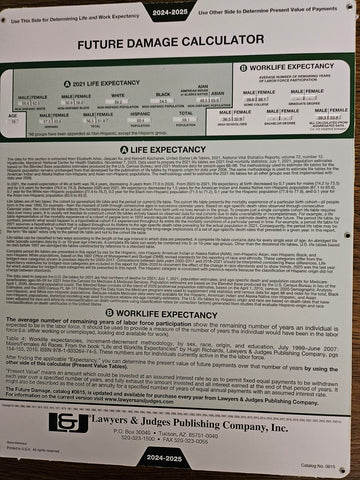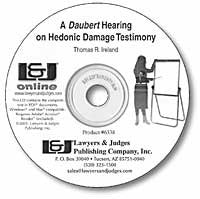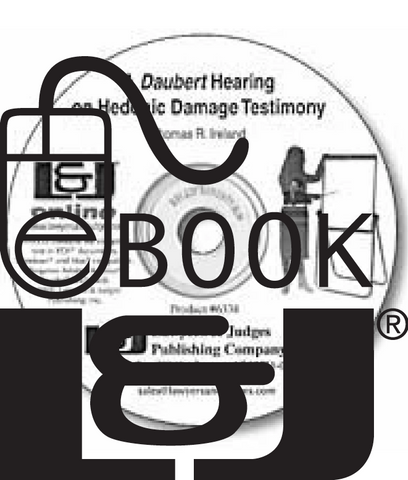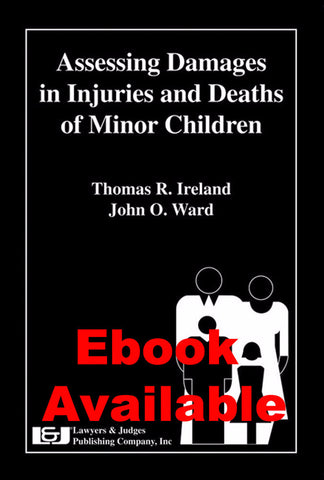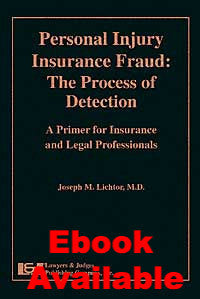
Personal Injury Insurance Fraud
- Author: Joseph M. Lichtor
- ISBN 10: 1-930056-34-6
- ISBN 13: 978-1-930056-34-3
- Copyright Date Ed: July 30, 2002
- Pages: 190 pages
- Binding Information: Hardcover
- Size: 6 ✕ 9 Inches (US)
Fraud is commonly defined as deliberate deception for unfair or unlawful personal gain. Patients, physicians, other medical providers and attorneys all may engage in fraud. Healthcare fraud is a major growth industry that costs millions annually, which cost is passed on to the public. It is not a problem that will correct itself.
Any attempt to eradicate fraud must include prevention, investigation, and prosecution. Dr. Lichtor presents many examples of accidental injury, such as auto accidents, slip and falls, home hazards, and more. You will learn the ways to investigate claims and discover whether a claimant has truly been injured. You will also read about the current methods of prevention.
Essential to this task is physician compliance with federal regulations for documentation and conformance with recognized medical guidelines for patient evaluation, management and billing. To stop doctor-patient deception, there must be early validation of an injury claim and limitation of services in accordance with acknowledged need and natural history of the alleged condition.
Since every true accident will leave a paper trail, including medical records and police reports, this is one important way to catch people attempting to commit fraud. Learn about the others by ordering this book today.
TOPICS INCLUDE
- Definitions and history of personal injury fraud
- Fraud prevention
- Accident investigation
- Accident history (records)
- Symptoms, diagnoses and treatment
- Examination and tests for physiological dysfunction
- Aggravation of pre-existing conditions
- Whiplash and back injury
- Traumatic fibromyalgia
- Repetitive motion injury
- Impairment, disability and fraud
- Abnormal illness behavior for personal gain
- Workers' compensation fraud
- Federal fraud enforcement
Table of Contents
DedicationPreface
Chapter 1: Introduction
1.1 Personal Injury Fraud
1.2 Medicare and Medicaid Fraud
1.3 History of Personal Injury Fraud
A. Europe
B. America
C. Railway spine
D. Whiplash
E. Ambulance chasers
F. Los Angeles
G. Accident staging
References
Chapter 2: Fraud Prevention
2.1 Introduction
2.2 Overview
2.3 A Method of Prevention
2.4 Summary
2.5 Conclusions
2.6 Examples
Reference
Chapter 3: Accident Investigation
3.1 Introduction
3.2 Slip and Fall
3.3 Auto Accident
3.4 Investigation
3.5 Accident Scene Records
3.6 Emergency Room (ER)
3.7 The Mechanics of Injury
A. Forgotten wisdom--The mechanism of injury
B. Examples of delayed discovery
C. Office care
D. Life activities
E. Work
F. Home, social, recreational
G. Travel
I. Occupations
I. Examples of injury and function
3.8 Summary
3.9 Conclusions
3.10 Examples
Chapter 4: Accident History (Records)
4.1 Introduction
4.2 Guidelines for Record Assessment
A. Subjective information derived from the patient--history, past history, present complaints
B. Objective information derived from physical examination
C. Imagery and electrical studies
4.3 The Accident Paper Trail
A. Accident environment
B. Physical and emotional response
C. Police
D. Ambulance
E. Emergency care
F. Hospital care
4.4 Summary
4.5 Conclusions
4.6 Examples
References
Chapter 5: Symptoms
5.1 Introduction
5.2 The Use of Pain to Promote Fraud
A. Introduction and definition
B. Quality of information
5.3 Onset and Resolution of Symptoms
5.4 Symptom Variation
5.5 Focused Inquiry into the Complaint
5.6 Normal Injury Behavior
5.7 Abnormal Injury Behavior
5.8 Psychological Factors
5.9 Summary
5.10 Conclusions
5.11 Examples
References
Chapter 6: Physical Examination
6.1 Introduction
6.2 Physical Injury Pain
6.3 Clinical Features of Physical Injury Pain
6.4 Clinical Features of Contrived Injury Pain
6.5 Detection of Abnormal Pain Behavior
6.6 Demonstration of Abnormal Pain Responses (Credibility Testing)
6.7 Subjective versus Objective
6.8 Examination Procedures
A. General aspects
1. Observation
2. Sensory detection
3. Demonstration
4. Manipulation
B. Patient's responses
C. Tenderness, spasm and restricted motion
1. Tenderness
2. Spasm
3. Restricted motion
D. Abnormal behavior during examination
E. Normal versus abnormal findings
6.9 Quality of Data
A. Competent data
B. Incompetent data
6.10 Summary
6.11 Conclusions
6.12 Examples
References
Chapter 7: Tests for Physiological Dysfunction
7.1 Introduction
7.2 Electrophysiologic Tests
7.3 Electromyogram (EMG)
7.4 H-Reflex Test
7.5 Nerve Conduction Study (NCS)
7.6 Conclusions
7.7 Examples
Reference
Chapter 8: Tests for Anatomical Definition
8.1 Introduction
8.2 Standard X-rays
8.3 Myelography
8.4 CT, MRI, CT Myelography
8.5 Indications for Use
8.6 Arthrography
8.7 Conclusions
8.8 Examples
References
Chapter 9: The Claimant's History (Background and Lifestyle)
9.1 Introduction
9.2 Life Activities
9.3 Occupation
9.4 Medical and Other History
9.5 Patient's Influence
9.6 Doctor's Influence
9.7 Summary
9.8 Conclusions
9.9 Examples
Reference
Chapter 10: Diagnosis
10.1 Introduction
10.2 Injury and Disability Diagnosis
A. Patient's influence
B. Doctor's influence
C. Physician compliance
1. Accuracy of diagnosis
2. Diagnostic deception
D. Accuracy of diagnosis
E. Diagnostic deception
10.3 Conclusion
10.4 Examples
Reference
Chapter 11: Aggravation of Pre-Existing Conditions
11.1 Introduction
11.2 Identification of Pre-Existing Conditions
11.3 Pre-Existing Physical Status
11.4 Determination of Injury
11.5 Response and Recovery
11.6 Conclusions
11.7 Examples
References
Chapter 12: Whiplash
12.1 Introduction
12.2 Diagnosis
12.3 Quebec Task Force
12.4 Neck Injury Evaluation
A. Accident history
B. The patient∂s history
C. Symptoms
D. Documentation of injury
E. Physical injury myths
F. X-rays
G. Diagnosis classification
12.5 Treatment and Recovery
12.6 Social Effects of Whiplash Pain Compensation
12.7 Neck Injury Research and Expectations
A. Anatomy of whiplash
B. Whiplash expectations
12.8 Lawyers' Response
12.9 Examples
References
Chapter 13: Back Injury
13.1 History
13.2 Quebec Task Force on Spinal Disorders
A. Introduction
B. Diagnosis
C. Classification of low back pain
D. Management
E. Conclusions
13.3 Clinical Practice Guidelines for Acute Low Back Problems in Adults
A. Introduction
B. Mandate
C. Classification
D. Treatment
E. Special diagnostic studies
F. Conclusions
13.4 Accidents and Back Injury
A. Introduction
B. Physical examination
C. Regional backache
D. Summary
13.5 The Back Book
13.6 Summary
13.7 Examples
13.8 Postscript
References
Chapter 14: Traumatic Fibromyalgia
14.1 Introduction
14.2 Symptoms
14.3 Physical Examination
14.4 Tests
14.5 Diagnosis
14.6 Treatment
14.7 Trauma
14.8 Personal Injury Litigation--Fibromyalgia Attributed to Trauma
A. Mackie v. Wolfe
B. The judge's conclusions
14.9 Example
References
Chapter 15: Repetitive Motion Injury
15.1 General
15.2 Terminology
15.3 Pathology
15.4 Symptoms
15.5 Diagnosis
15.6 Summary
15.7 Conclusions
15.8 Examples
References
Chapter 16: Treatment
16.1 Introduction
16.2 History and Evolution
16.3 Treatment Guidelines
16.4 Treatment of Pain
16.5 Treatment Decisions
16.6 Excessive Treatment
16.7 Unnecessary Surgery
16.8 Conclusions and Recommendations
16.9 Examples
Reference
Chapter 17: Impairment, Disability and Fraud
17.1 Definitions and Introduction
17.2 Injury, Disease, and Disability
17.3 Disability Exploitation
17.4 Total Disability Retirement
17.5 Summary
17.6 Conclusions
17.7 Examples
References
Chapter 18: Abnormal Illness Behavior for Personal Gain
18.1 Introduction
18.2 Disease versus Illness
18.3 Behavior Games
18.4 Manifestations of Abnormal Illness Behavior
18.5 Features of AIB after an Auto Accident
18.6 Credibility Evaluation--IME
A. Observations
B. Physical examination
C. Credibility testing
D. Nonorganic signs
18.7 Conclusions
18.8 Examples
References
Chapter 19: Workers' Compensation Fraud
19.1 Introduction
19.2 Participants
19.3 Suspicion of Fraud
A. Suspicious account of the accident
B. Suspicious timing of the claim
C. Suspicious nature and extent of the injury
19.4 Medical Evaluation
19.5 Independent Medical Examination (IME)
19.6 Conclusions
19.7 Examples
References
Chapter 20: Federal Fraud Enforcement
20.1 Introduction
20.2 Professional Ethics and Competence
20.3 Documentation
20.4 Standards for Evaluation and Management
20.5 Federal Guidelines
A. Coding
B. Billing
C. Auditing
20.6 Enforcement
20.7 Summary
20.8 Conclusions
20.9 Examples
20.10 Emergency Room
References
About the Author
Index

